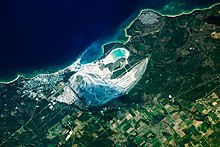User:JaneYin/Calcite
Extended content[edit]
Properties
Distribution
Use and application
Climate change
Properties[edit]
Thermoluminescence
Calcite has thermoluminescent properties mainly due to manganese divalent (Mn2+).[1] An experiment was conducted by adding activators such as ions of Mn, Fe, Co, Ni, Cu, Zn, Ag, Pb, and Bi to the calcite samples to observe if they emitted heat or light. The results showed that adding ions (Cu+, Cu2+, Zn2+, Ag+, Bi3+, Fe2+, Fe3+, Co2+, Ni2+) did not react.[1] However, a reaction occurred when both manganese and lead ions were present in calcite.[1] By changing the temperature and observing the glow curve peaks, it was found that Pb2+ and Mn2+ acted as activators in the calcite lattice, but Pb2+ was much less efficient than Mn2+.[1]
Mineral thermoluminescence can form various glow curves of crystals under different conditions, such as temperature changes, because impurity ions or other crystal defects present in minerals supply luminescence centers and trapping levels.[1] Observing these curve changes also can help infer geological correlation and age determination. [1]
Distribution[edit]
Calcite is found all over the world, and its leading global distribution is as follows:
The United States

Calcite is found in many different areas in the United States. One of the best examples is the Calcite Quarry in Michigan.[2] The Calcite Quarry is the largest carbonate mine in the world and has been in use for more than 85 years.[2] Large quantities of calcite can be mined from these sizeable open pit mines.
Canada
Calcite can also be found throughout Canada, such as in Thorold Quarry and Madawaska Mine, Ontario, Canada. [3]
Mexico
Abundant calcite is mined in the Santa Eulalia mining district, Chihuahua, Mexico.[4]
Iceland
Large quantities of calcite in Iceland are concentrated in the Helgustadir mine.[5] The mine was once the primary mining location of "Iceland spar".[6] However, it currently serves as a nature reserve, and calcite mining will not be allowed.[6]
England
Calcite is found in parts of England, such as Alston Moor, Egremont, and Frizington, Cumbria. [5]
Germany
St. Andreasberg, Harz Mountains, and Freiberg, Saxony can find calcite. [5]
Use and application[edit]
Microbiologically precipitated calcite also can be used for tailings management and is designed to promote sustainable development in the mining industry. [7]
Calcite can help synthesize precipitated calcium carbonate (PCC) (mainly used in the paper industry) and increase carbonation.[8] Furthermore, due to its particular crystal habit, such as rhombohedron, hexagonal prism, etc., it promotes the production of PCC with specific shapes and particle sizes.[8]
Calcite can be formed naturally or synthesized. However, artificial calcite is the preferred material to be used as a scaffold in bone tissue engineering due to its controllable and repeatable properties.[9]
Climate change[edit]

Climate change is exacerbating ocean acidification, which may lead to lower natural calcite production. The oceans absorb large amounts of CO2 from fossil fuels emission into the air.[10] The total amount of artificial CO2 absorbed by the oceans is calculated to be 118 ± 19 Gt C.[11] If a large amount of CO2 dissolves in the sea, it will cause the acidity of the seawater to increase, thereby affecting the pH value of the ocean.[10] Calcifying organisms in the sea, such as molluscs foraminifera, crustaceans, echinoderms and corals, are susceptible to pH changes.[10] Meanwhile, these calcifying organisms are also an essential source of calcite. As ocean acidification causes pH to drop, carbonate ion concentrations will decline, potentially reducing natural calcite production.[10]
Reference[edit]
- ^ a b c d e f Medlin, W. L. (1959). "Thermoluminescent properties of calcite". he Journal of Chemical Physics. 30(2): 451–458.
- ^ a b NASA. "Calcite Quarry, Michigan". Earth observatory. Retrieved 17 February 2023.
- ^ Hudson Institute of Mineralogy. "Calcite from Canada". mindat.org. Retrieved 17 February 2023.
- ^ Hudson Institute of Mineralogy. "Santa Eulalia Mining District, Aquiles Serdán Municipality, Chihuahua, Mexico". mindat.org. Retrieved 17 February 2023.
- ^ a b c AZoMining. "Calcite – occurrence, properties, and distribution". EDITORIAL FEATURE. Retrieved 17 February 2023.
- ^ a b Kristjansson, L. (2002). "Iceland Spar: The Helgustadir Calcite Locality and its Influence on the Development of Science". Journal of Geoscience Education. 50(4): 419-427.
- ^ Zúñiga-Barra, H.; Toledo-Alarcón, J.; Torres-Aravena, Á.; Jorquera, L.; Rivas, M.; Gutiérrez, L.; Jeison, D. (2022). "Improving the sustainable management of mining tailings through microbially induced calcite precipitation: A review". Minerals Engineering. 189: 107855–.
- ^ a b Jimoh, O. A.; Ariffin, K. S.; Hussin, H. B.; Temitope, A. E. (2018). "Synthesis of precipitated calcium carbonate: a review". Carbonates and Evaporites. 33(2): 331–346.
- ^ Chróścicka, A.; Jaegermann, Z.; Wychowański, P.; Ratajska, A.; Sadło, J.; Hoser, G.; Michałowski, S.; Lewandowska-Szumiel, M. (2016). "Synthetic Calcite as a Scaffold for Osteoinductive Bone Substitutes". Annals of Biomedical Engineering. 44(7): 2145–2157.
- ^ a b c d Tyrrell, T. (2008). "Calcium carbonate cycling in future oceans and its influence on future climates". Journal of Plankton Research. 30(2): 141–156.
- ^ Sabine, C. L.; Feely, R. A; Gruber, N.; Key, R. M.; Lee, K.; Bullister, J. L; ...; Rios,, A. F. (2004). "The oceanic sink for anthropogenic CO2". science. 305(5682): 367-371.
{{cite journal}}:|last7=has numeric name (help)CS1 maint: extra punctuation (link)
